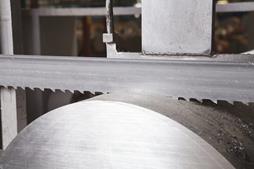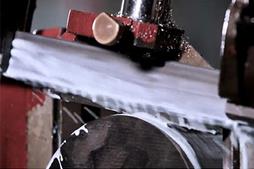Common bandsaw problems and how to fix them!
15-03-2022
What can I check on my saw?
Guides and guide arms
You have to check and adjust the saw guides regularly. Check if they are worn out, and replace if necessary. Position guide arms as close to the work piece as possible.
Problems:
Band breakage – guides are worn out or guide settings are too wide.
Crooked sawing/cutting out of line/square – guides are too far apart, worn out or poorly adjusted, guide arm loose.
Vibration – guides need adjusting.
Bandwheels
The band wheels have to be kept in good condition and properly aligned.
Problems:
Band breakage – Band wheels worn or too small – try thinner bands
Band slips on wheel – Driving wheel is worn out
Chip Brush
Check that the swarf brush is properly adjusted and change it regularly.
Problems:
Tooth breakage – Swarf brush does not work; gullets filled
Rapid tooth wear – Swarf brush does not work
Band Tension
The correct band tension is needed to get a straight cut. Measure with tensionmeter.
Problems :
Band breakage – Band tension too high
Crooked Sawing – Band tension too low
Vibration – Band tension too low
Band slips on wheel – Band tension too low
Coolant / Cutting Fluid. Needed to lubricate and to cool.
Check concentration with a Bahco refractometer. Use good coolant. It should reach the cut with low pressure and with generous flow
Problems:
Rapid tooth wear – Too little coolant or incorrect concentration
What speeds and feeds should I be using on my saw?
Band Speed
The band speed has to be chosen correctly. Check the band speed with a tachometer.
Problems:
Crooked sawing/cutting out of line/square – Band speed too low
Rough surface finish – Band speed too low
Rapid tooth wear – Band speed too high
Vibration – Natural vibration, band speed is slightly high or low
Feed Rate
The feed rate has to be chosen so that the teeth of the bandsaw blade can work properly
Problems:
Band breakage – Feed rate too high
Crooked sawing – Feed rate too high
Tooth breakage – Feed rate too high
Rough surface – Feed rate too high
Rapid tooth wear – Feed rate too high
Vibration – Feed rate too high
Band slips on wheel – Feed rate too high
Am I using the correct saw blade?
Tooth Pitch
The selection of the right tooth pitch is just as important as choosing the right feed and speed
Problems:
Crooked sawing – Tooth pitch too fine
Tooth breakage – Tooth pitch too fine Gullets filled
Rough surface – Tooth pitch too coarse
Rapid tooth wear – Tooth pitch too fine
Tooth Shape
Every tooth shape has its ideal application
Problems:
Tooth breakage – Tooth shape too weak
Rapid tooth wear – Wrong tooth shape selection
Vibration – Use combo
Running In
A new bandsaw blade should be run in to obtain maximum bandsaw lifetime. Never saw in old kerf.
Problems:
Rough surface – Band not properly run in
Rapid tooth wear – Band not properly run in
Vibration – Band not properly run in
Blade Life
All blades wear out eventually. Look for signs of wear.
problems:
Crooked sawing – Blade worn out
Rough surface – Blade worn out
Band slips on wheel – Blade worn out
What material am I using?
Surface
A bad surface (scale) of the work piece will shorten the life of the blade. Lower the band speed.
Problems:
Rapid tooth wear – Surface defects, i.e. scale, rust, sand
Clamping
Securely clamp work pieces, especially when bundle cutting. Do not use bent or damaged work pieces.
Problems:
Tooth breakage – Work piece moves
Vibration – Work piece not properly clampedVisit the ADS Precision Ltd website for more information on Common bandsaw problems and how to fix them!




